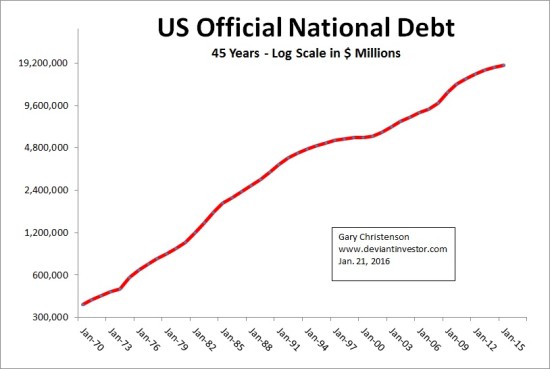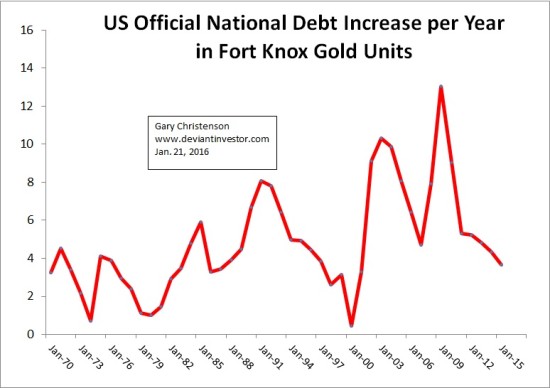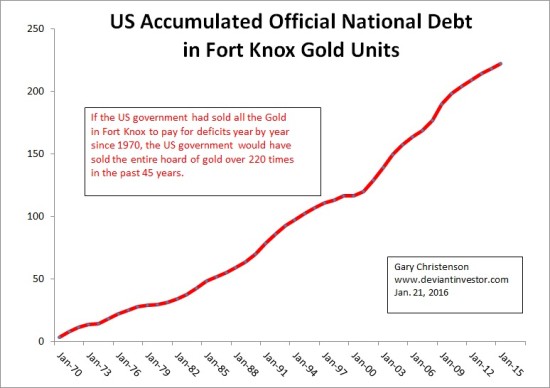Everyone knows that government expenses and deficits are out of control. Think U.S., Europe, the U.K., Japan, and others. So what?
- Borrowing today supposedly brings spending forward from the future, so future spending should be curtailed. It hasn’t happened so far.
- But no government will reduce spending so they must either borrow more or devalue their currency via “money printing,” various forms of QE – bond monetization, or increasing taxes. Not sustainable!
- Global debt exceeds $200 Trillion – a number so large it is essentially incomprehensible. S. official debt is about $19 Trillion with unfunded liabilities in the $100 – $200 Trillion range. Again – incomprehensible.
- All of the above create problems – huge problems. Ignoring those problems makes the ultimate “reset” worse. Unsustainable!
Everyone knows that the U.S. officially holds a massive supply of gold in the Fort Knox Bullion Depository – about 147,000,000 ounces of gold. It hasn’t been audited in 60+ years, but let’s pretend it still exists.
To put the debt, deficits and craziness into perspective, compare debt and deficits to ounces of gold and to the gold officially vaulted in Fort Knox.
First: Examine the official U.S. national debt (in $ millions) on a log scale since 1970. The exponential trend is evident. Note that the national debt has gone up from under $400 billion to nearly $19 Trillion – $19,000 Billion.

Second: Take the INCREASE in the national debt each year and divide by the average price of gold that year. The graph shows the INCREASE in the national debt each year measured in gold ounces. Note that the average increase in the debt was about 710,000,000 ounces of gold EACH year since 1970.

Third: Remember that Fort Knox officially contains 147,341,858 ounces of gold. Define that as one FKGU – one Fort Knox gold unit. Now show the above graph in FKGU’s. How much did the US government increase its debt EACH year since 1970 by the equivalent value of all the gold in Fort Knox? Note that the average for EACH year since 1970 was about 4.8 FKGU.
Repeat: The US government INCREASED the official national debt by the “value” of all the gold in Fort Knox about 4.8 times EACH year since 1970. Unsustainable!
Fourth: Now add up the national debt increases in FKGU’s since 1970. This shows the total official national debt, in FKGU’s, as it has been accumulated since 1970. Note that the accumulated national debt, valued year by year in total official Fort Knox Gold Units, now exceeds 220.

Repeat: The official debt of the U.S. government, measured each year in the total “value” of all the gold officially vaulted in Fort Knox, would have spent the Fort Knox gold over 220 times. Unsustainable – this is not a viable system.
Really? The U.S. (and other countries) is so deeply in debt that the accumulated year by year deficits would have spent the entire hoard of Fort Knox Gold over 220 times. This suggests:
- Even if the gold has not been stolen or sold, 147 million ounces of gold is tiny and irrelevant compared to the mountain of debt – unless gold prices are revalued much higher.
- The mountain of debt can’t be paid, so it must be defaulted, either directly or via devaluation of the currency.
- What is a T-Bond actually worth if the borrowed capital can’t be repaid or will be repaid in mini-dollars?
- If the value of T-Bonds, notes, etc. is reset lower, since they can’t be repaid, what does that do to retirement accounts, pension funds, and most other assets? Reset much lower?
- Will the Fed and other central banks quietly observe most paper assets crashing in value, like oil has crashed in value, or will they “do something?” The financial and political elite will expect action to save their paper assets.
CHOICES? What will the Fed do?
Per John Rubino:
- “Intimate that the Fed’s balance sheet has contracted enough and maybe it’s time for it to stabilize (translation: a new but modest round of QE).
- When that fails, promise to expand the existing QE program by an amount calculated to turn the market’s frown upside down.
- When that fails, begin a new experiment with a catchy name like “QE for the people” or “debt jubilee” or NIRP, featuring the helicopter money that Ben Bernanke long ago promised to deploy in case of full-blown deflation …”
CHOICES? More QE, “bond monetization,” bail-ins, pension fund confiscations, higher taxes, helicopter money, tax rebates, who knows? In essence – “a new deal” that tries to bail out and extend the corrupt system at the expense of … guess who? There will be substantial trauma.
As Charles Hugh Smith says, “Virtually every major program of every major nation-state is financially unsustainable going forward.” Financial triage, along with most government programs, will fail, so expect considerable trauma in 2016 – 2020.
